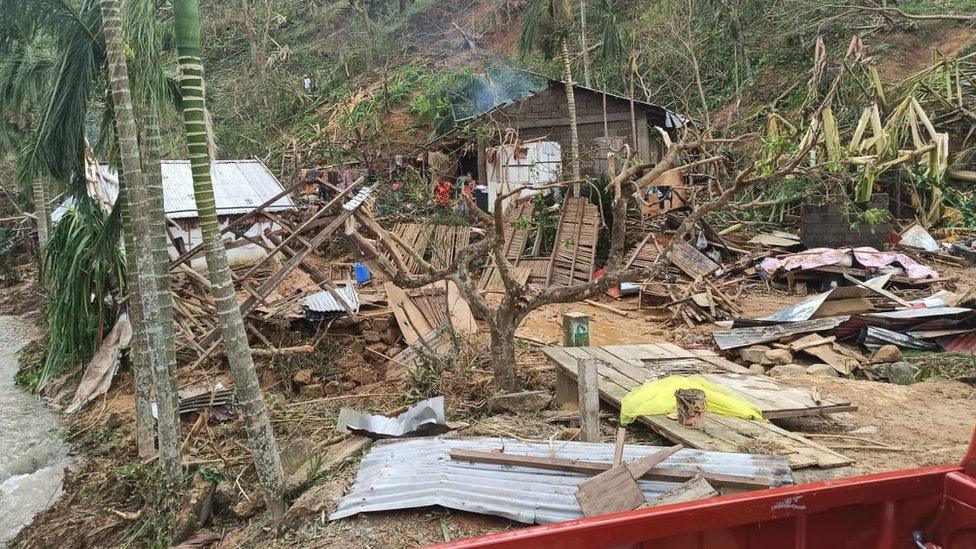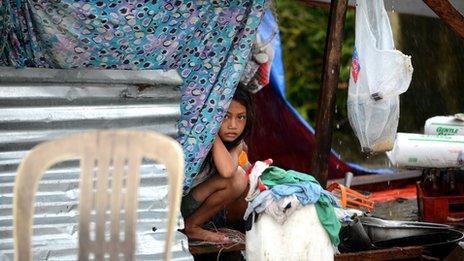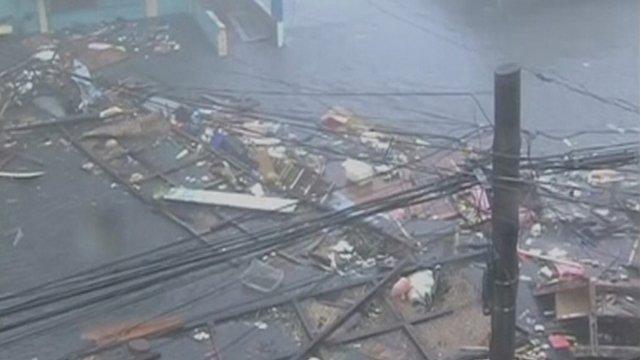Typhoon Goni: Fears after Philippine town said to be 90% damaged
- Published
Typhoon devastates Philippines islands
A typhoon which slammed into the Philippines on Sunday may have damaged 90% of the buildings in the first town it struck, according to the Red Cross.
Philippines Red Cross Chairman Dick Gordon said an assessment suggested that Virac, home to 70,000 people, had been severely damaged by Typhoon Goni.
At least 16 people were killed after the storm made landfall on Sunday on Catanduanes island as a super typhoon.
Goni has now been downgraded to a tropical storm.
Civil defence officials estimate about 370,000 people have been displaced by the storm and tens of thousands of homes have been destroyed, though the capital Manila was largely spared.
Goni - known as Rolly in the Philippines - is the most powerful storm to hit the country since Typhoon Haiyan killed more than 6,000 people in 2013.
What damage has Goni caused?
Virac was the first urban area on Catanduanes to be hit by the storm. Communication lines have been down since Sunday and it has been difficult getting information out of the area.
The Red Cross confirmed to the BBC that teams on the ground had made a "visual" assessment which suggested between "80-90%" of the municipality's buildings were damaged by the storm.

Gigmoto, another municipality in the Catanduanes was badly hit by the storm
Mr Gordan said the current damage to the town was "like 70% of [Typhoon] Haiyan's damage".
At least six people have died across the island province of Catanduanes. The Philippine Red Cross has also said there is no access to electricity, no water and no cellular network.
But there is said to be little damage to the region's airport and seaports.

On social media, many have been tweeting with the hashtag #NasaanAngCatanduanes or "Where is Catanduanes", calling on local media to provide updates.
Ten people, including a five-year-old, were reported to have died in Albay province. Two drowned, another was swept away by volcanic mud and another killed by a falling tree.
In the Guinobatan municipality, also in Albay province, Representative Zaldy Co of the Ako Bicol party list told news agency Reuters said more than 300 houses were buried under volcanic debris.

Houses in Guinobatan are said to be buried under volcanic ash
The party list added that several people were believed to be buried alive.
The entire Bicol region currently remains without electricity.
In Quezon province, power supplies were cut in 10 towns after the typhoon toppled trees.
How did the Philippines prepare?
The Philippines is used to powerful storms - it is hit by an average of 20 storms and typhoons a year and lost 22 people when Typhoon Molave barrelled through the same region last week.
But this year preparations have been complicated by the Covid-19 virus, which has already caused 380,739 infections and led to 7,221 deaths in the Philippines.
Some 347,000 people were evacuated, civil defence chief Ricardo Jalad said - revising down the one million figure he mentioned ahead of the storm.

Gyms and schools have been converted into covid-secure emergency shelters for people
Coronavirus patients being treated in isolation tents had been evacuated, officials said.
Ports and airports were shut, and schools, gyms and government-run evacuation centres were being used for covid-secure emergency shelters.
"Evacuating people is more difficult at this time because of Covid-19," Bicol regional civil defence spokesman Alexis Naz told AFP on Saturday.
- Published11 November 2013

- Published8 November 2013
